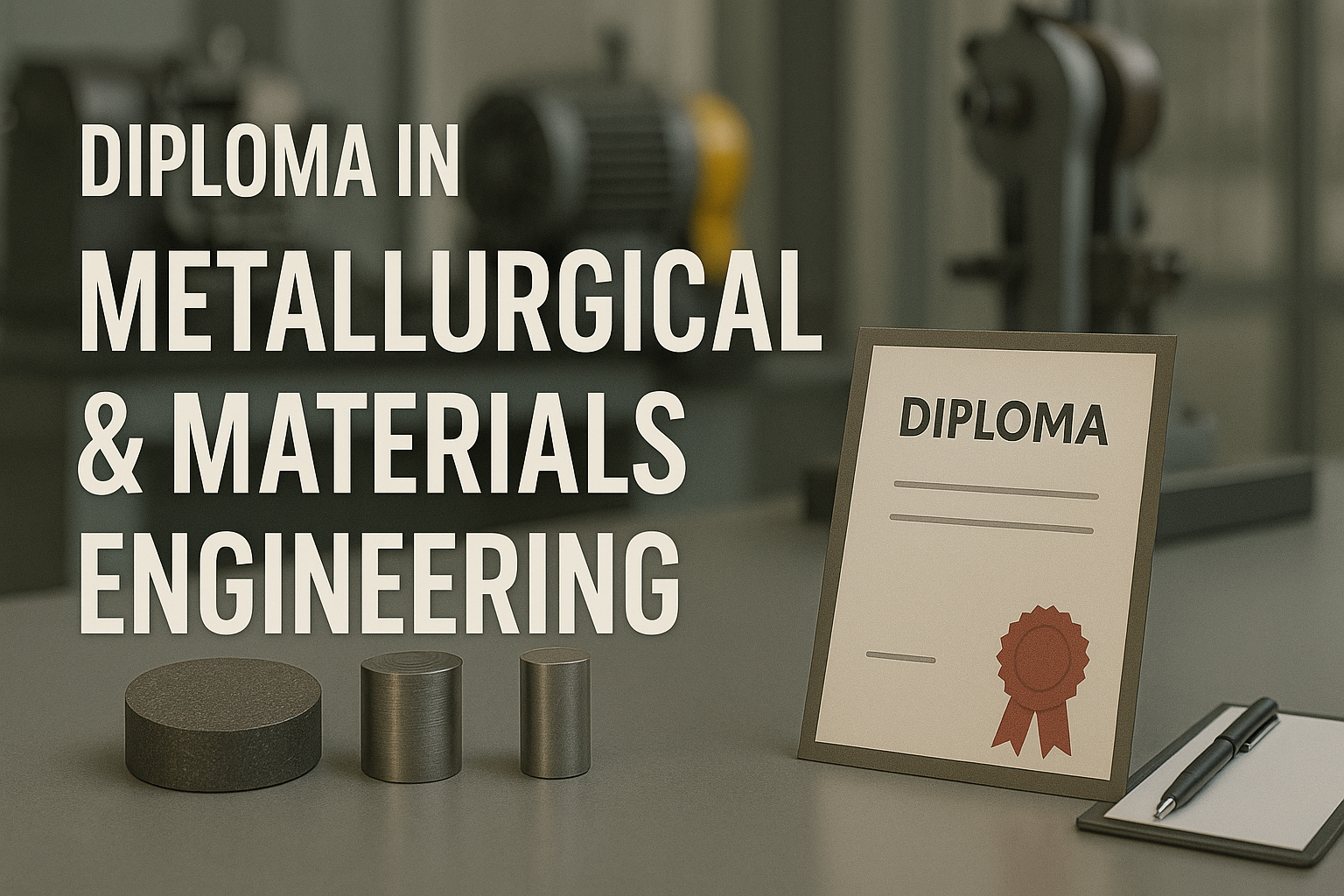Ever wondered what goes into the steel holding up a skyscraper or the lightweight alloys in a jet engine? It all comes down to materials. A Diploma in Metallurgical and Materials Engineering is your entry into this fascinating, hands-on field, training you to become a skilled technician in an industry that literally builds the world around us.
If you’re looking for a practical, in-demand career, this guide breaks down everything you need to know about the program—what you’ll learn, how to get in, and where it can take you.
What is This Diploma, Anyway?
Think of this program as your launchpad into the science of metals. It’s less about abstract theory and more about the practical skills needed on the job.
You’ll see it called “Diploma in Metallurgical Engineering” or, more commonly now, “Diploma in Metallurgical and Materials Engineering.” That small addition of “Materials” is a big deal. While traditional metallurgy is all about metals, modern industry needs technicians who also understand polymers, ceramics, and composites. This broader scope makes you far more versatile and valuable in sectors from automotive to aerospace.
For any technical diploma in India, two approvals are non-negotiable. They are your guarantee that the qualification is legitimate and recognized everywhere.
- AICTE (All India Council for Technical Education): This is the national seal of approval, ensuring the college meets standards for its curriculum, labs, and faculty.
- SBTE (State Board of Technical Education): Each state has its own board that conducts exams and awards the final diploma, ensuring quality control at the regional level.
Most students take the standard three-year, six-semester path. However, if you’ve already completed 12th grade with a PCM background or a relevant ITI course, you can use the popular lateral entry option to jump directly into the second year, finishing your diploma in just two years.
Getting In: The Admission Process
Admissions are handled by state-level authorities to keep the process fair and merit-based. Your main job is to keep an eye on deadlines and have your documents in order.
For first-year entry, you’ll need to have passed your Class 10 (SSC) exam with at least 35% to 50% marks, including Mathematics and Science as compulsory subjects.
The selection process varies by state. Some hold a Polytechnic Common Entrance Test, while others create a merit list based on your Class 10 marks. Most states use a Centralized Admission Process (CAP), where you register online, list your college preferences, and are allotted a seat based on your rank.
Be ready with your documents for verification. This is a crucial step to confirm your eligibility. You’ll need:
- Mark sheets (Class 10, 12, or ITI)
- Transfer Certificate (TC)
- Domicile Certificate (to prove you’re a resident of the state)
- Caste, Non-Creamy Layer (NCL), or EWS certificates, if applicable
- Passport-sized photos and a valid photo ID
What You’ll Actually Learn: A Look at the Curriculum
The curriculum is designed to walk you through the entire life cycle of a metal—from raw ore to a finished, tested product. You’ll start with foundational science and build up to specialized, hands-on subjects.
While the exact order might differ, your three years will look something like this:
The labs are where the real learning happens. You won’t just read about testing materials; you’ll be in the Mechanical Testing Lab operating a Universal Testing Machine to measure a steel rod’s tensile strength. You won’t just study heat treatment; you’ll be in the Heat Treatment Lab, taking a piece of metal, heating it in a furnace, quenching it, and seeing firsthand how its hardness changes.
Other key hands-on experiences include:
- Metallography Lab: Preparing metal samples and analyzing their internal crystal structure under a microscope.
- Foundry and Casting Lab: Making sand molds and learning the fundamentals of how molten metal is poured to create parts.
- Welding Lab: Getting behind the mask to practice common welding techniques.
- Non-Destructive Testing (NDT) Lab: Learning how to find hidden flaws in a component without damaging it.
To tie it all together, you’ll complete a capstone project in your final year and spend 4-6 weeks in in-plant training at a real company. This internship is often your direct bridge to a job offer.
Beyond the Classroom: Industry Exposure and Career Paths
A good diploma program doesn’t isolate you on campus. It actively connects you with the industry you’re about to join through plant visits, guest lectures from industry experts, and formal partnerships with local companies. These connections are often what separate a good graduate from a great one.
So, where can this diploma take you? Graduates are in high demand for a variety of hands-on technical roles. You could find yourself working as a:
- Metallurgical Lab Technician, analyzing microstructures to ensure quality.
- Heat-Treatment Technician, operating furnaces to strengthen critical components.
- Foundry Technician, supervising the casting of everything from engine blocks to pump housings.
- Quality Inspector, performing tests to make sure products meet tough industry standards.
- NDT Trainee, using specialized equipment to detect flaws in welds and parts.
These roles are needed across a huge range of sectors, including:
- Automotive and Transportation: A massive employer, from car manufacturers to the companies that supply their parts.
- Steel and Metal Production: The foundational industry, with jobs in large plants and mills.
- Heavy Engineering and Fabrication: Building the machinery and infrastructure that powers the country.
- Aerospace and Defense: Working with high-performance alloys and materials.
- Testing and Service Labs: Providing specialized services like materials testing, NDT, and heat treatment to other industries.
The diploma is also a fantastic launchpad. The most common next step is getting lateral entry into a B.E. or B.Tech. program, allowing you to earn a full engineering degree in just three more years. You can also pursue professional certifications in high-demand fields like welding inspection or NDT to become a specialized expert.
The Rules of the Game: Safety, Standards, and Documentation
Working in metallurgy means operating in a world of strict standards and regulations. Safety is paramount. In an environment with molten metal and heavy machinery, an unsafe technician is an unemployable one. Your program will drill you on the non-negotiable use of Personal Protective Equipment (PPE) and safe operating procedures.
You’ll also learn the language of the industry: quality standards like ISO 9001 and material specifications from bodies like IS and ASTM.
Finally, you’ll learn the critical importance of documentation. In this field, if it isn’t documented, it didn’t happen. A test result is meaningless without a proper report, and a heat treatment cycle is worthless without a furnace chart. You’ll be trained to maintain the meticulous records that are the backbone of industrial quality and traceability.
The Payoff: Placements and What to Expect
Let’s talk about the bottom line: jobs and salaries. Reputable polytechnics have strong placement records, with rates often ranging from 40% to over 85%.
Here’s a realistic look at starting salaries:
- Highest packages for top students can range from ₹3.24 LPA to ₹5.5 LPA.
- The average starting salary typically falls between ₹2.2 LPA and ₹3.0 LPA.
- Entry-level offers generally begin around ₹1.8 LPA.
Major companies from across the Indian industrial landscape recruit directly from these programs. You’ll see names like Tata Motors, Bajaj Auto, JSW Steel, Bharat Forge, and Larsen & Toubro (L&T) on campus.
How Much It Costs and How to Pay for It
One of the biggest advantages of this diploma, especially from a government college, is its affordability.
- Government Polytechnics: Tuition fees are highly subsidized, often ranging from just ₹6,000 to ₹18,000 per year.
- Private Polytechnics: Fees are significantly higher, typically between ₹35,000 and ₹1,00,000 per year.
Don’t let the cost deter you. A wide range of government scholarships are available for students from reserved categories and low-income families. The Tuition Fee Waiver Scheme (TFWS) also provides a full tuition waiver for meritorious students in need. And of course, all major banks offer education loans for this program.
Choosing the Right College
How can you tell a great program from an average one? Look for signs of quality. Beyond the mandatory AICTE approval, check if the program is accredited by the National Board of Accreditation (NBA). NBA accreditation is a rigorous, voluntary process that signals a commitment to excellence and is highly respected by employers.
When you visit a campus, pay close attention to the labs. Is the equipment modern and well-maintained? Does the college have strong industry partnerships? These are the things that will shape your practical education and your career prospects.
Ready to Apply?
The application process in most states is centralized and online through the state’s Directorate of Technical Education (DTE) website. Keep an eye on their portal for admission announcements, key dates, and the official information brochure.
For specific questions about the program, don’t hesitate to contact the Head of the Metallurgical Engineering department at the colleges you’re interested in. They can give you the most detailed and up-to-date information.
Is This Diploma Right for You?
If you’re a hands-on learner who wants a direct path to a stable, career-oriented technical field, a Diploma in Metallurgical and Materials Engineering is an excellent choice. It equips you with practical, in-demand skills and offers a clear route for future growth, whether you choose to enter the workforce immediately or pursue a B.Tech. degree.
By investing three years in this foundational program, you’re preparing yourself for a career spent building, testing, and innovating the very materials that make our modern world possible.




